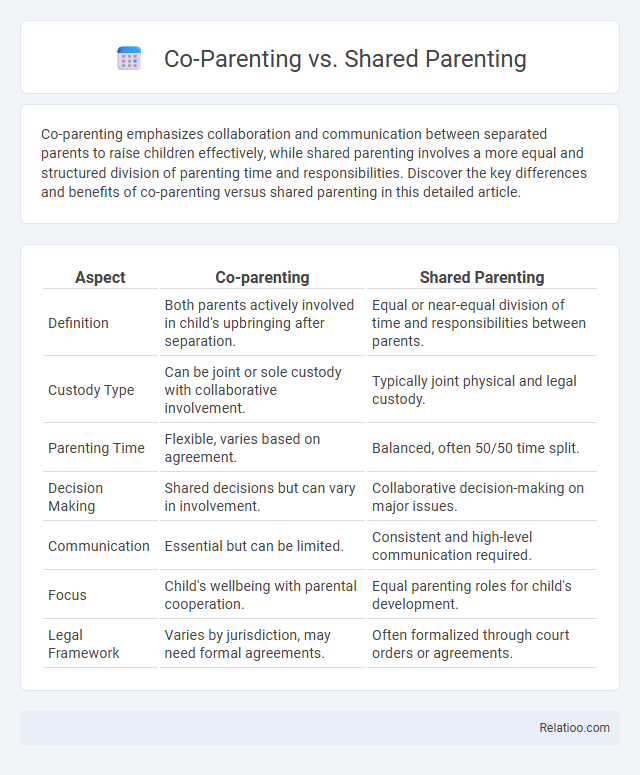Co-parenting emphasizes collaboration and communication between separated parents to raise children effectively, while shared parenting involves a more equal and structured division of parenting time and responsibilities. Discover the key differences and benefits of co-parenting versus shared parenting in this detailed article.
Table of Comparison
| Aspect | Co-parenting | Shared Parenting |
|---|---|---|
| Definition | Both parents actively involved in child's upbringing after separation. | Equal or near-equal division of time and responsibilities between parents. |
| Custody Type | Can be joint or sole custody with collaborative involvement. | Typically joint physical and legal custody. |
| Parenting Time | Flexible, varies based on agreement. | Balanced, often 50/50 time split. |
| Decision Making | Shared decisions but can vary in involvement. | Collaborative decision-making on major issues. |
| Communication | Essential but can be limited. | Consistent and high-level communication required. |
| Focus | Child's wellbeing with parental cooperation. | Equal parenting roles for child's development. |
| Legal Framework | Varies by jurisdiction, may need formal agreements. | Often formalized through court orders or agreements. |
Understanding Co-parenting: Definition and Key Features
Co-parenting involves both parents actively participating in raising their child while maintaining separate households and decision-making responsibilities, emphasizing collaboration despite personal differences. Shared parenting typically refers to a legal arrangement where both parents equally share physical custody and parenting time, ensuring balanced involvement in the child's daily life. Understanding co-parenting means recognizing its focus on effective communication, mutual respect, and prioritizing Your child's well-being above all else.
What is Shared Parenting? An Overview
Shared parenting refers to a custody arrangement where both parents actively participate in raising their child, typically splitting time and responsibilities more evenly than traditional co-parenting models. This approach emphasizes equal decision-making authority and physical time spent with the child, often aiming to preserve strong relationships with both parents after separation or divorce. Research shows shared parenting supports better emotional and developmental outcomes for children compared to sole custody arrangements.
Legal Differences: Co-parenting vs Shared Parenting
Legal differences between co-parenting and shared parenting primarily revolve around custody arrangements and decision-making authority. Co-parenting often refers to a collaborative approach without necessarily formal legal agreements, while shared parenting typically involves a court-ordered joint custody where both parents have equal rights and responsibilities. Understanding these distinctions helps you navigate custody terms and ensures your parental rights align with the legal framework governing your family's situation.
Communication Styles in Each Parenting Approach
Co-parenting emphasizes collaborative decision-making with open, respectful communication tailored to prioritize the child's wellbeing, often requiring conflict resolution skills to manage disagreements. Shared parenting involves more equal division of parenting responsibilities, demanding consistent, clear, and frequent communication to coordinate schedules, discipline, and routines effectively between households. In parallel parenting, communication is typically minimal and highly structured, designed to reduce conflict and maintain boundaries, with exchanges strictly focused on the child's needs without unnecessary personal interaction.
Decision-Making Dynamics in Co-parenting and Shared Parenting
Decision-making dynamics in co-parenting often involve flexible communication and negotiated compromises, allowing parents to adjust roles based on the child's needs and circumstances. Shared parenting typically emphasizes equal responsibility and joint decision-making authority, ensuring that both parents have an active role in setting rules, education, and healthcare decisions for Your child. Understanding these distinct approaches helps optimize collaboration, leading to better outcomes in family stability and child well-being.
Parental Responsibilities and Role Distribution
Parental responsibilities in co-parenting typically involve both parents collaborating informally to support the child's needs, whereas shared parenting legally mandates nearly equal division of time and decision-making authority. In co-parenting arrangements, role distribution is often flexible and negotiated based on individual circumstances, while shared parenting requires structured schedules and clear division of duties to ensure balanced involvement. The nuanced differences affect how decisions on education, health, and daily care are managed, directly impacting consistency and stability for the child.
Child’s Well-being: Emotional and Psychological Impact
Co-parenting, shared parenting, and parallel co-parenting each significantly influence a child's emotional and psychological well-being, with shared parenting often promoting stability by ensuring balanced involvement from both parents. Consistent communication and cooperation in co-parenting models contribute to reduced anxiety and better emotional adjustment in children. Conversely, limited interaction in parallel co-parenting may lead to feelings of neglect or divided loyalty, impacting a child's overall mental health.
Challenges Faced in Co-parenting vs Shared Parenting
Co-parenting often involves navigating conflicting parenting styles and communication breakdowns, which can create tension and inconsistency in child-rearing, whereas shared parenting typically requires a more structured division of responsibilities and time that demands high levels of cooperation and flexibility. Your success in either approach hinges on establishing clear boundaries and maintaining mutual respect to prioritize the child's well-being. Challenges in co-parenting arise from emotional conflicts and lack of coordination, while shared parenting's difficulties center on logistics and equal involvement.
Tips for Successful Parenting Partnerships
Successful parenting partnerships thrive on clear communication, mutual respect, and consistent boundaries, regardless of whether the arrangement is co-parenting, shared parenting, or joint custody. Establishing detailed parenting plans, prioritizing the child's best interests, and maintaining flexibility help minimize conflicts and foster a healthy environment. Utilizing conflict resolution techniques and keeping open lines of communication with ex-partners supports long-term cooperation and nurtures positive child development.
Choosing the Best Approach for Your Family
Choosing the best approach for your family involves understanding the distinctions between co-parenting, shared parenting, and collaborative parenting. Co-parenting typically emphasizes cooperative decision-making while living separately, shared parenting often includes equal time and responsibilities with both parents actively involved, and collaborative parenting focuses on resolving conflicts respectfully for the child's welfare. Your family's unique dynamics, communication style, and children's needs should guide the selection of the most effective parenting strategy.

Infographic: Co-parenting vs Shared Parenting
 relatioo.com
relatioo.com